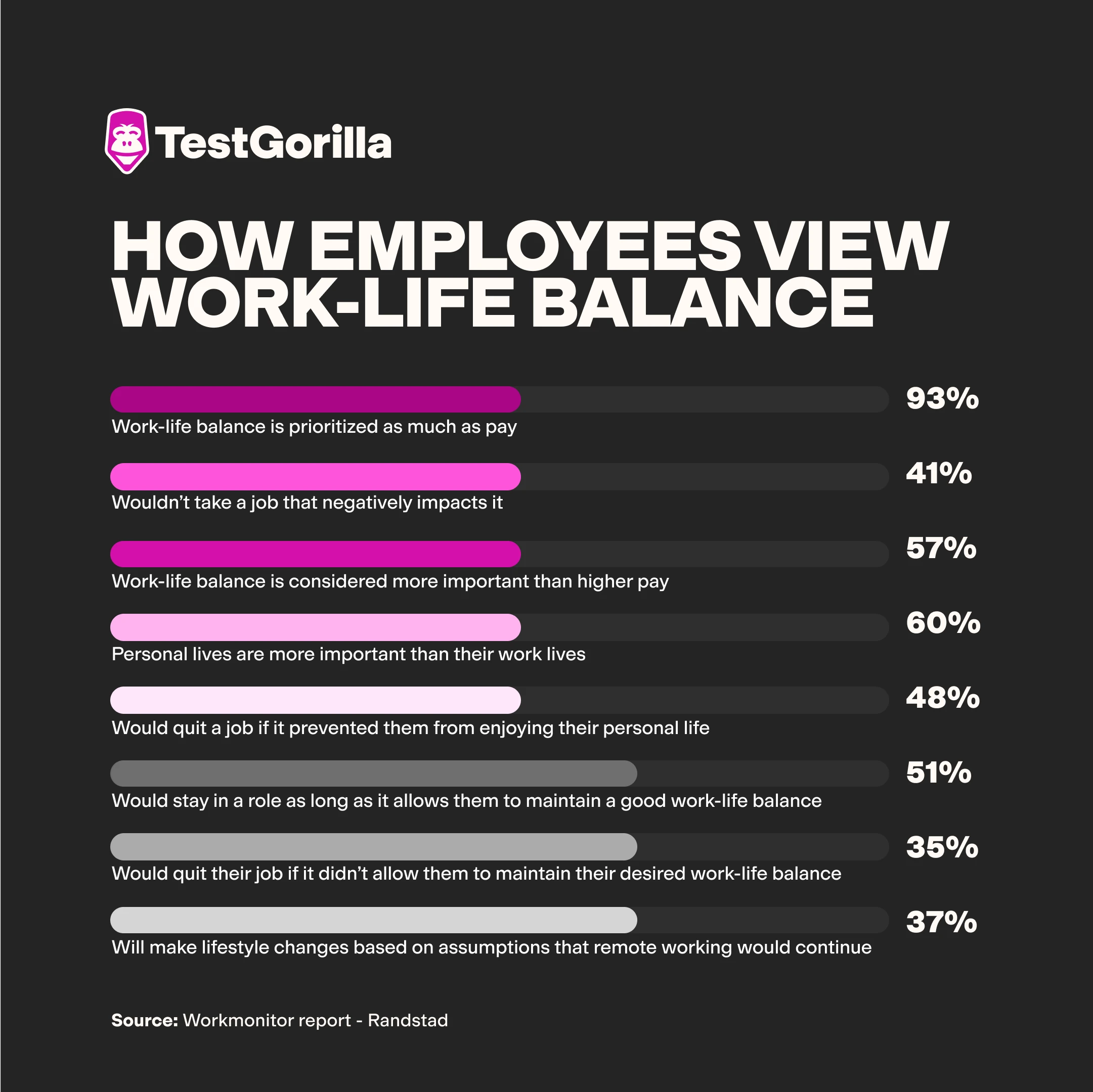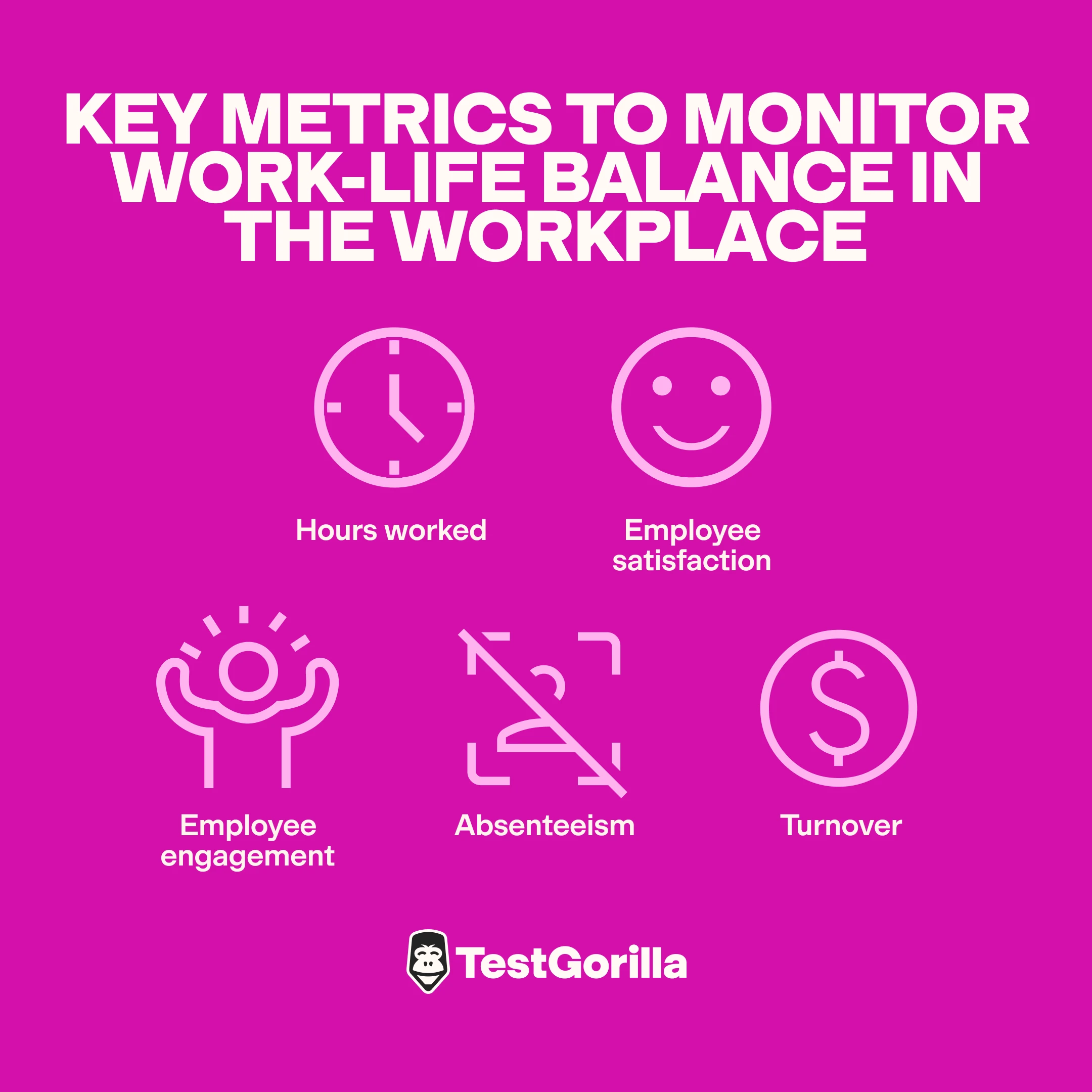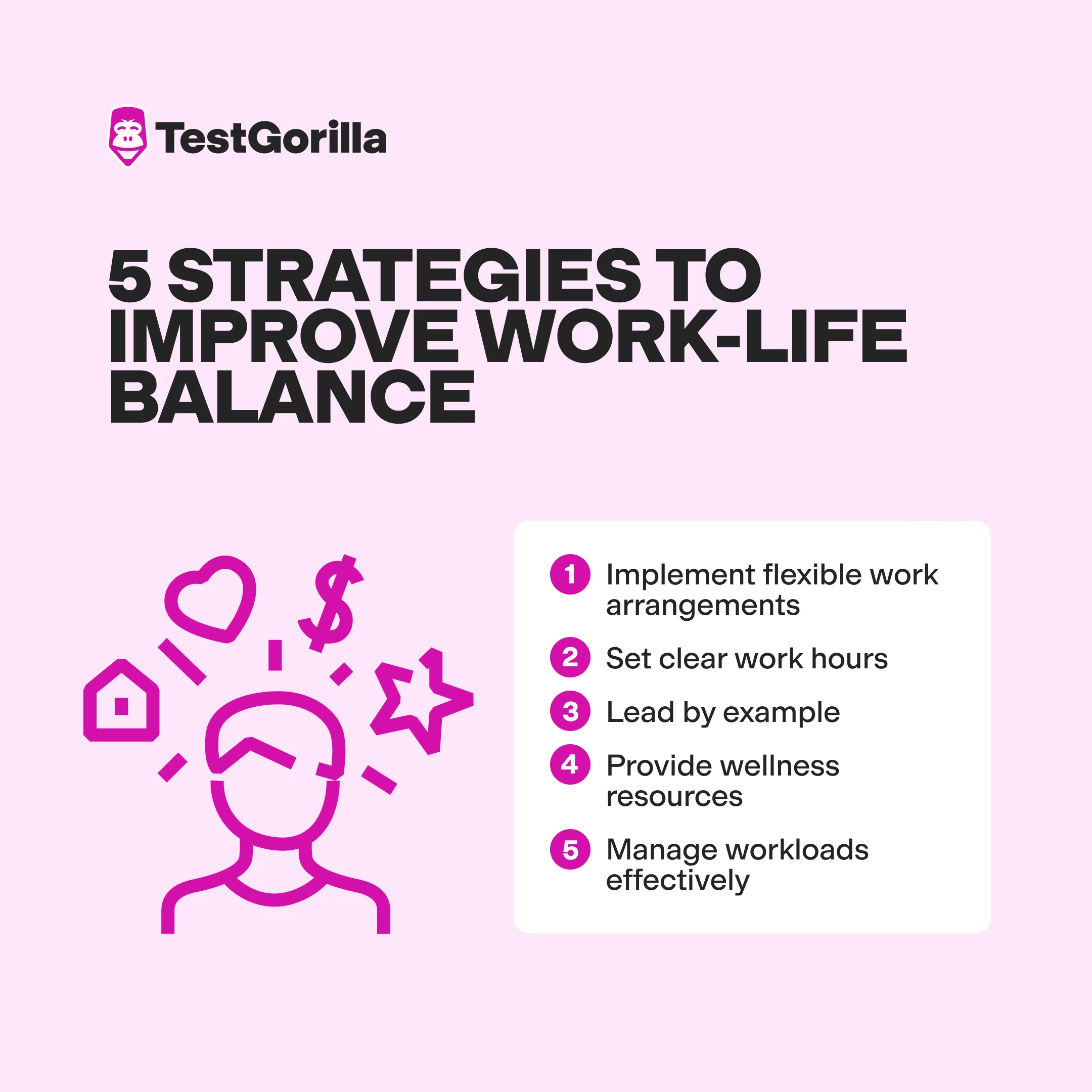Work-life balance is a big topic for workplaces today, but what do the numbers say?
We’ve created this research-packed article on work-life balance statistics to show how balance affects employees and companies. We also share tips on how to measure work-life balance and how you can improve it at your company.
Table of contents
- How we researched this topic
- Key takeaways
- The current state of work-life balance
- How employee work-life balance impacts your business
- Work-life balance across generations
- Work-life balance trends in remote and hybrid work
- Gender disparities in work-life balance
- Measuring work-life balance in the workplace
- Strategies to improve work-life balance
- Hire better candidates with talent assessments
- FAQs
How we researched this topic
To assemble this guide, we used data from Randstad’s 2024 Workmonitor report, Gallup, McKinsey & Company, the American Psychological Association, and other studies.
Key takeaways
Work-life balance is a top priority. 93% of employees value work-life balance as much as pay, and 60% say personal life matters more than work.
Flexibility boosts retention. 60% of employees would stay longer at a company offering flexible work options.
Stress costs businesses. Poor work-life balance leads to $190 billion in work-related stress costs annually.
Leaders set the tone. 50% of employees say their manager is crucial in shaping their work-life balance.
The best insights on HR and recruitment, delivered to your inbox.
Biweekly updates. No spam. Unsubscribe any time.
The current state of work-life balance
Work-life balance has been on the rise since 2020. In fact, a report by the Conference Board indicates that overall job satisfaction in the US reached 62.3% in 2022, with improvements noted in non-compensation factors like work-life balance.
How employees view work-life balance
Today’s employees care more about work-life balance than most other factors that impact their job satisfaction. Work-life balance also influences their job choices and decisions in their personal lives.
Randstad’s 2024 Workmonitor report revealed some eye-opening statistics:
93% of employees prioritize work-life balance as much as pay, and 41% say they wouldn’t take a job that negatively impacts it.
57% consider work-life balance more important than higher pay when looking at their next career move.
60% said their personal lives are more important than their work lives.
48% would quit a job if it prevented them from enjoying their personal life.
51% would stay in a role they like, even if it doesn’t offer career progression, as long as it allows them to maintain a good work-life balance.
35% would quit their job if it didn’t allow them to maintain their desired work-life balance.
37% reported making lifestyle changes (e.g., moving houses or getting pets) based on assumptions that remote working would continue.
Work-life balance satisfaction in different industries
According to Remote’s analysis, here are the industries with the highest and lowest work-life balance satisfaction:
Finance and insurance come out on top for work-life balance – likely due to their high pay, flexible schedules, and generous leave.
Education takes second place, thanks to short workweeks (32.5 hours on average) and 29 days of leave outside of school breaks.
Architecture and engineering land in third place with decent remote work options (11.37%) and pay averaging $44,278 per year. Employees are happy here and get 26 days of leave each year.
Accommodation and food services struggle the most with work-life balance. Low pay, unpredictable hours, and high stress make it tough, and the 140% turnover rate shows just how challenging it is.
How employee work-life balance impacts your business
Impact on employee health and well-being
71% of employees feel their employer cares about their mental health, which helps enhance overall well-being.
Employees experiencing burnout are 63% more likely to take sick days.
95% of HR professionals link the loss of good employees to job burnout, often due to poor work-life balance.
Impact on workplace morale and culture
57% of workers view work-life balance as the most important factor for morale.
Companies that support work-life balance have 50% lower healthcare costs.
23% of women and 15% of men are in a toxic workplace with low morale, often linked to poor work-life balance.
Impact on productivity and engagement
Companies that offer work-life balance programs report an 85% increase in productivity.
Poor work-life balance can cause employees to disengage from their roles and responsibilities. Research shows that disengaged employees are 18% less productive.
Impact on employee retention and recruitment
Businesses providing a good work-life balance have 25% less employee turnover.
73% of workers consider work-life balance a core factor when choosing a job. Additionally, 57% of candidates would consider declining a job offer if they feel it would negatively affect their work-life balance.
59% of employees have considered quitting a job due to poor work-life balance.
Work-life balance across generations
Research has highlighted some big differences in how generations view work-life balance.
According to Randstad’s 2024 Workmonitor report:
51% of Gen Z workers (born 1997–2012) say flexible hours are essential to them, compared to just 31% of Baby Boomers (born 1946–1964).
51% of Millennials (born 1981–1996) prioritize flexible hours when looking for a new job, while only 37% of Gen X individuals (born 1965–1980) feel the same.
That said, studies have also shown some similarities across generations:
37% of all US employees say they wouldn’t accept a new job if it didn’t offer flexibility around work locations.
40% say they wouldn’t take a role without flexibility.
All generations expect management to prioritize work-life balance.
Of course, work-life balance isn't just about flexible hours; it also involves mental health support, manageable workloads, and growth opportunities. Here’s how different generations view these aspects:
Mental health support
Baby Boomers often keep mental health issues private but are becoming more open to discussing them, which could signal a shift in this generation prioritizing mental health support at work.
Millennials and Generation Z prioritize mental health, actively seek support, and expect employers to provide resources.
Manageable schedules and workloads
Generation X workers prefer flexibility and autonomy in their work schedules.
Baby Boomers prefer structured work environments with clear hierarchies.
Opportunities for growth
67% of Gen Z individuals want to work at companies offering skill development to advance their careers.
Millennials also want purposeful work and opportunities for growth, valuing feedback and mentoring.
Work-life balance trends in remote and hybrid work
Randstad’s 2024 Workmonitor report includes interesting trends around work-life balance across remote and hybrid environments:
54% of remote workers say their job allows them to maintain a healthy work-life balance.
60% of hybrid workers feel they can balance work and personal lives.
37% would consider quitting their job if asked to spend more time in the office.
41% of workers prioritize flexible working hours, slightly ahead of flexible work locations (37%).
While Randstad found that 47% of in-office workers struggle to manage work and personal life, Buffer concluded that just 11% of remote workers say their work-life boundaries are either “somewhat unhealthy” or “very unhealthy.” This further signals that remote working is
Gender disparities in work-life balance
Women struggle more than men with work-life balance, and there are several potential reasons for this. According to a 2024 Gallup study:
Women with children are more likely to be the “go-to” parent for handling childcare needs.
64% of women with children say they’re the primary parent expected to manage unexpected childcare issues, compared to 22% of men.
Women (38%) and men (37%) are about equally likely to agree their workplace offers enough flexibility for childcare responsibilities.
Nearly half of working women experience high daily stress, compared to 43% of men.
17% of women are more likely to handle personal or family care duties while at work, compared to 11% of men. This can overwhelm and negatively impact their work and lead to burnout.
Women report higher stress at work than men, largely due to caregiving responsibilities.
Measuring work-life balance in the workplace
Here are key metrics your HR team should track to monitor work-life balance at your organization:
Hours worked: Track how many hours employees work each week to make sure no one is overworking. At most, your team members should log 40 hours per week unless they’ve been approved to work (get paid for) overtime.
Employee satisfaction: Use surveys to ask employees how happy they are with their roles, responsibilities, and work-life balance. You can also use surveys to ask what your company could do to improve staff’s work-life balance.
Employee engagement: Monitor employee participation in meetings and projects and their enthusiasm about their work. To measure engagement more formally, send out pulse surveys or ask questions during performance reviews.
Absenteeism: Poor work-life balance often results in higher absenteeism. So, track workers’ unexpected absences, like last-minute call-outs or no-shows. Frequent patterns in teams or roles can indicate a need for intervention.
Turnover: Track how many employees leave your company in a given period, and remember to hold exit interviews so you can find out why.
Strategies to improve work-life balance
Below are strategies that can help you improve work-life balance for your team:
1. Implement flexible work arrangements
If the job doesn’t have to be done in a particular location 100% of the time, allow employees to work where they feel comfortable – within reason. For instance, they might work at home or, if your business has multiple locations, a location closer to their home.
You can also allow employees to adjust their work hours or work remotely to accommodate personal commitments. For example, you might let workers start their day anytime between 8am and 9am.
2. Set clear work hours
To respect personal boundaries, define specific working hours, and discourage work-related communications after these times. For example, if your office hours are from 9am to 6pm, consider implementing a policy against sending emails after hours. This way, your employees can disconnect and recharge.
3. Lead by example
When leaders prioritize work-life balance, it tells employees they can do the same without fear of negative repercussions. So, encourage your staff to follow your lead by taking vacation time and not sending work-related emails during evenings and weekends.
4. Provide wellness resources
If your organization has the resources, consider offering Employee Assistance Programs (EAPs), mental health support, and wellness workshops. For example, you might provide employees access to counseling services or organize monthly wellness seminars on topics like stress management and healthy living.
5. Manage workloads effectively
Start by setting realistic project timelines and monitoring workloads to avoid overloading your staff. You can regularly review team members’ assignments to ensure no one is overburdened and adjust deadlines or redistribute tasks as necessary.
Hire better candidates with talent assessments
Work-life balance is a top priority for employees, with 93% considering it a key factor when choosing a job, second only to salary. That’s why you need to offer flexibility and support for employee wellbeing to attract top talent and improve retention.
Once you’ve drawn in grade-A candidates, you’ll need an effective, bias-free way to check that they’re a good fit for your team. Using a talent assessment tool like TestGorilla can help you do just that.
Combine up to five science-backed tests from our vast library to create a custom assessment that evaluates everything from personality traits to job-specific skills and culture add.
Ready to get started? Sign up for a free account or request a free demo today.
FAQs
How many hours is a good work-life balance?
A good work-life balance typically means working a maximum of 40 a week.
However, work-life balance isn’t just about the hours you work – it’s also about having enough time for personal activities, rest, and relationships outside of work. One effective approach is the “8-8-8 rule,” which divides the day into three parts: 8 hours for work, 8 hours for sleep, and 8 hours for personal time.
What percentage of your life is at work?
If you work 40 hours a week for 50 weeks a year, that’s about 33% of your time spent at work.
You've scrolled this far
Why not try TestGorilla for free, and see what happens when you put skills first.

















